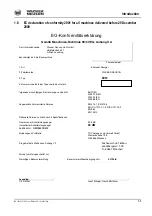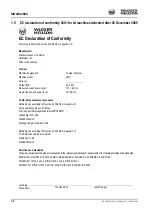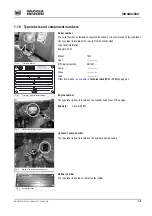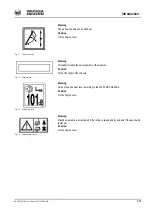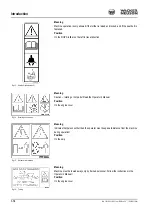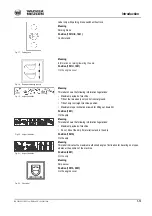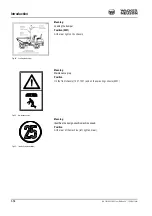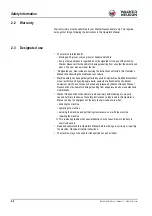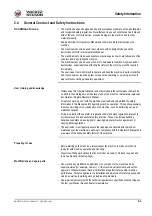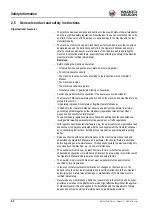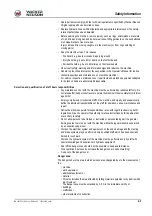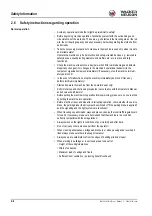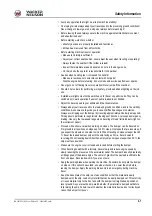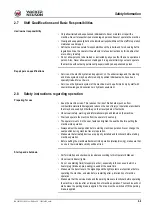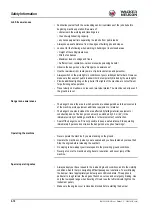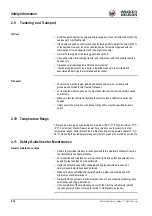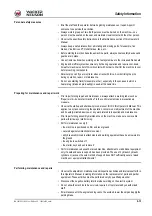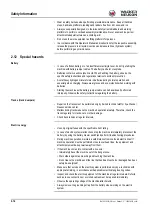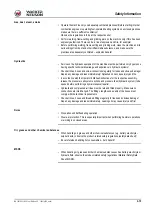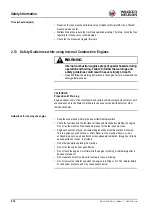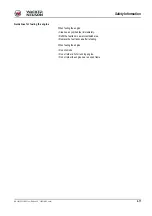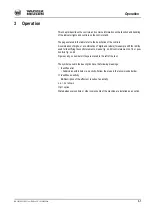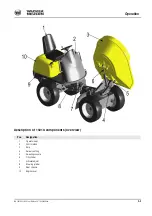
BA 1001/1501/2001 us – Edition 3.3 * 12001b210_us.fm
2-7
Safety Information
• Avoid any operation that might be a risk to machine stability!
• On sloping terrain always adapt your travel speed to the prevailing ground conditions!
Never change to lower gear on a slope but always before reaching it!
• Before leaving the seat always secure the machine against unintentional movement
and unauthorized use!
• Before starting work check whether
• all safety devices are properly installed and functional.
• dirt has been removed from all footholds.
• Before starting machine travel or operation:
• Make sure visibility is sufficient!
• Adjust your correct seat position, never adjust the seat when traveling or operating!
• Always fasten the seat belt if the rollbar is raised!
• Inspect the immediate area and ensure no one is in the danger zone.
• On the job site the operator is responsible for third parties!
• Caution when handling fuel – increased fire hazard!
• Make sure fuel does not come into contact with hot parts!
Stop the engine before refueling, do not smoke and avoid open flames or sparks.
• Never get on or off during travel or operation! Never jump off the machine!
• Should it be too dark for performing work safely, provide additional lighting on the job
site.
• Installed work lights must not be switched on for travel on public roads. They can be
switched on in work operation if users of public roads are not blinded.
• Adjust the travel speed to your abilities and the circumstances.
• Always adapt your travel speed to the road and ground conditions, and to the visibility
conditions. Ask someone to guide you in case of difficult passages or obstacles.
Always avoid tipping over the dumper by traveling appropriately and slowly as required.
This applies in particular to rough terrain, the edges of trenches, curves and emergency
braking. Use only the low speed range when traveling off-road (turtle indicator light on
the instrument panel).
• Proceed with extreme care when working on slopes. The dumper can be traveled on
firm ground in all positions on slopes up to 25 % steep. On slopes that are less steep if
you expect the wheels on one side to sink in. When traveling on slopes steeper than 25
%, travel the loaded dumper only with the skip facing uphill, i.e. travel downhill
reversing. When traveling downhill with an empty skip on slopes steeper than 25 %, the
skip must face downhill.
• Make sure the engine cover is closed and locked before starting the dumper.
• When traveling downhill with a full skip, travel slowly and reduce engine speed by
slowly reducing the pressure on the accelerator pedal. The dumper brakes hydraulically
at idling speed of the diesel engine. The center of gravity of the payload is shifted to the
front on slopes. Reverse downhill if you are not sure.
• Apply the parking brake when parking the machine. If possible, do not park the dumper
on slopes. If this cannot be avoided, use wheel chocks, etc. Lower the skip before
leaving the dumper. Apply the parking brake only in an emergency during machine
travel.
• Keep the base plate of the skip in a clean condition so that the material is easily
dumped out of the skip. Load only material that can be easily dumped out. Tilt out sticky
or frozen material only to the front and with the dumper in straight-ahead position on
level ground. As you raise the skip, watch whether the material is dumped out before
fully raising the skip. Failure to watch whether the material is dumped out correctly can
cause the dumper to tip over.

